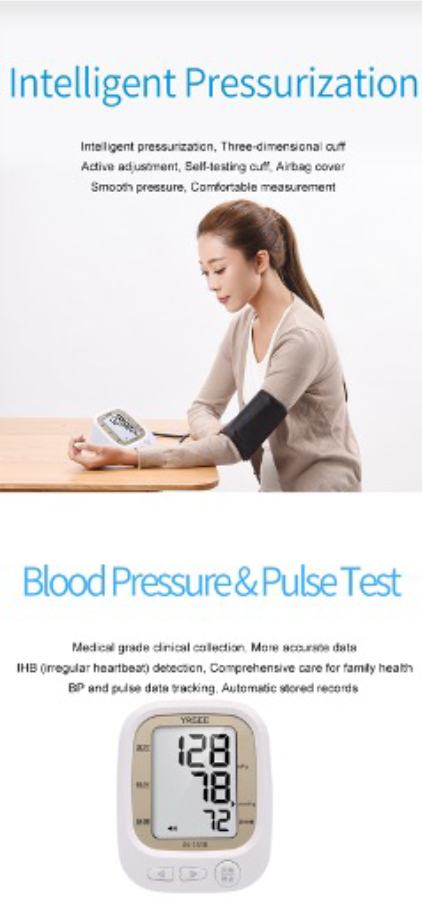
Why to monitor blood pressure, blood sugar, blood lipid, uric acid? What are the standards?
2023-04-04
How to choose best suitable varicose vein stockings?
2023-05-04For patients suffering from severe pain, finding effective pain management treatment is critical because it can improve your overall quality of life, but it may also be essential to your cardiovascular health. Medical researchers believe that there is a link between pain and high blood pressure. This means that if you struggle with widespread pain, you are at a higher risk of developing high blood pressure and other problems related to cardiovascular health.
Overview of Hypertension
Hypertension is a chronic disease characterized by continuous elevation of arterial blood pressure, which often causes lesions of the heart, brain, kidney, and other important organs and has corresponding consequences.
According to the blood pressure standard recommended by the World Health Organization (WHO), the normal adult systolic blood pressure should be less than or equal to 140mmHg (18.6kPa), and the diastolic blood pressure should be less than or equal to 90mmHg (12kPa). That is, the systolic blood pressure is between 141-159mmHg (18.9-21.2kPa) and the diastolic blood pressure is between 91-94mmHg (12.1-12.5kPa), which is borderline hypertension. When diagnosing hypertension, blood pressure must be measured multiple times, and at least two consecutive average diastolic blood pressures of 90mmHg (12.0kPa) or more can be diagnosed as hypertension. Patients with only one increase in blood pressure cannot be diagnosed, but follow-up observation is required.
Does pain raise blood pressure?
Studies have shown that pain stimulates sympathetic nerves causing increased myocardial contraction and vasoconstriction leading to increased blood pressure, pain causes excitation of the renin-angiotensin system, which releases angiotensin leading to vasoconstriction and increased heart rate causing increased blood pressure, and activation of the renin-angiotensin system causes an increase in aldosterone, leading to water and sodium retention causing increased blood pressure. Clinically, pain can lead to increased blood pressure. Common causes such as abdominal pain, pain caused by lumbar disc herniation, and pain caused by femoral neck fracture can lead to increased blood pressure, which will return to normal after pain relief.
In addition, the blood pressure of the human body will be affected by many environmental factors, such as prolonged fatigue, stress, lack of sleep, staying up late, mood swings, and traumatic pain may all increase blood pressure. Symptoms of pain are more predominant, monitor blood pressure. If it is significantly high, temporarily take a little blood pressure-lowering drug.
Emergency measures for hypertension
1. if the patient during the disease suddenly appear palpitations shortness of breath, then the patient should immediately be sitting breathing state, lips blue, limb movement failure, with pink foamy sputum, to consider acute left heart failure, the patient should be instructed to legs down, take a sitting position, such as the availability of oxygen bags, timely inhalation of oxygen, and quickly notify the emergency center
2. once the hypertensive patient’s blood pressure has a sudden rise, and also accompanied by nausea, vomiting, severe headache, panic, frequent urination, and even blurred vision and other symptoms appear, it means that the hypertensive patient has appeared hypertensive encephalopathy. So at this time, family members should comfort the patient not to be nervous, bed rest, and timely take antihypertensive drugs, but also another diuretic, sedatives, etc.
3. hypertensive patients after exertion or excitement, if the phenomenon of angina pectoris, or even symptoms of myocardial infarction or acute heart failure, such as pain in the precordial region, chest tightness, and extended to the neck, left shoulder back, or upper limbs, pale, cold sweat, then the family should immediately let the patient rest quietly, take nitroglycerin or a pentyl nitrite, and inhale oxygen
4. in life some hypertensive patients in the onset, perhaps accompanied by cerebrovascular symptoms, in addition to headache, vomiting, and other symptoms, and even appear impaired consciousness or limb paralysis, then the family should let the patient lie down, head to the side, so as to avoid impaired consciousness, or violent vomiting when the vomit inhaled airway, and then notify the emergency center.
Suffering from hypertension, the most important thing is to stabilize the blood pressure number, not to let it rise and fall suddenly. Experts say that good care of hypertensive patients can significantly reduce stroke and cardiac events.





